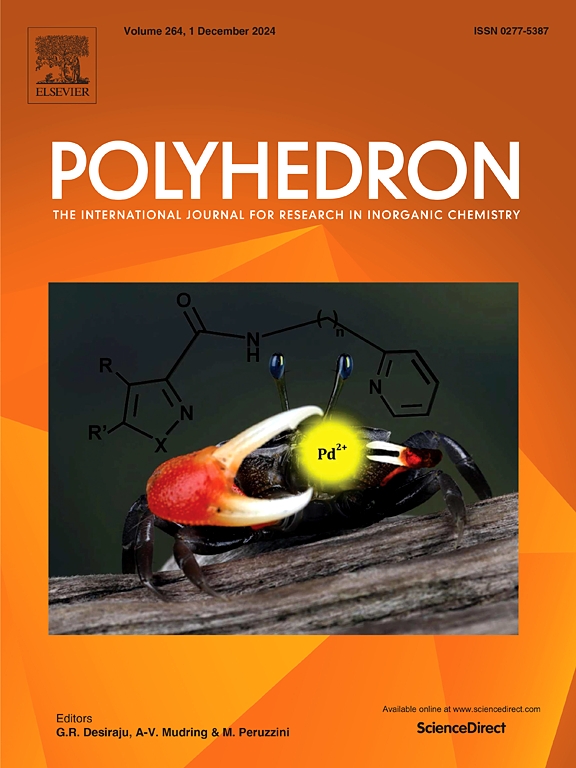In-silico investigation on electronic structures and electronic absorption spectra of quintuply bonded dimolybdenum complexes Mo2[μ-RʹC(N-2,6-iPr2-4-RC6H2)2]2 (Rʹ = H, Ph; R = H, CH3, OCH3, F, Cl, and CF3)
IF 2.4
3区 化学
Q2 CHEMISTRY, INORGANIC & NUCLEAR
引用次数: 0
Abstract
The electronic absorption spectra of the quintuply bonded dimolybdenum(I) complexes Mo2[μ-HC(N-2,6-iPr2-4-C6H3)2]2 (2(H)) and Mo2[μ-PhC(N-2,6-iPr2-4-C6H3)2]2 (3(H)) are presented and discussed. Allowed electronic transitions for these complexes, and their prototypical modelled complexes Mo2[μ-RʹC(N-2,6-iPr2-4-RC6H2)2]2 (where Rʹ = H, Ph; R = CH3, OCH3, F, Cl, and CF3) are calculated using time-dependent density functional theory (TDDFT). For two sets of six complexes, the electronic structure and nature of occupied frontier molecular orbitals are similar. The HOMO is constructed mainly by the Mo2-based δ orbital with some admixture of ligand-based π orbitals, while LUMO is mainly Mo2-based δ* orbital. The calculated absorption spectra of the complexes are scrutinized in comparison with the experimental spectra of 2(H) and 3(H).

五键二钼配合物Mo2[μ-R′C(n- 2,6- ipr2 -4- rc6h2)2]2的电子结构和电子吸收光谱的硅研究(R′= H, Ph;R = H, CH3, OCH3, F, Cl, CF3)
给出并讨论了五键二钼配合物Mo2[μ-HC(n -2,6- ipr2 -4- c6h3)2]2 (2(H))和Mo2[μ-PhC(n -2,6- ipr2 -4- c6h3)2]2 (3(H))的电子吸收光谱。允许这些配合物和它们的原型模型配合物Mo2[μ-R′C(n -2,6- ipr2 -4- rc6h2)2]2的电子跃迁(其中R′= H, Ph;R = CH3, OCH3, F, Cl和CF3)的计算使用时相关密度泛函理论(TDDFT)。对于两组6个配合物,其占据前沿分子轨道的电子结构和性质是相似的。HOMO主要由mo2基δ轨道和配体基π轨道组成,而LUMO主要由mo2基δ*轨道组成。计算得到的配合物吸收光谱与2(H)和3(H)的实验光谱进行了比较。
本文章由计算机程序翻译,如有差异,请以英文原文为准。
求助全文
约1分钟内获得全文
求助全文
来源期刊

Polyhedron
化学-晶体学
CiteScore
4.90
自引率
7.70%
发文量
515
审稿时长
2 months
期刊介绍:
Polyhedron publishes original, fundamental, experimental and theoretical work of the highest quality in all the major areas of inorganic chemistry. This includes synthetic chemistry, coordination chemistry, organometallic chemistry, bioinorganic chemistry, and solid-state and materials chemistry.
Papers should be significant pieces of work, and all new compounds must be appropriately characterized. The inclusion of single-crystal X-ray structural data is strongly encouraged, but papers reporting only the X-ray structure determination of a single compound will usually not be considered. Papers on solid-state or materials chemistry will be expected to have a significant molecular chemistry component (such as the synthesis and characterization of the molecular precursors and/or a systematic study of the use of different precursors or reaction conditions) or demonstrate a cutting-edge application (for example inorganic materials for energy applications). Papers dealing only with stability constants are not considered.
 求助内容:
求助内容: 应助结果提醒方式:
应助结果提醒方式:


